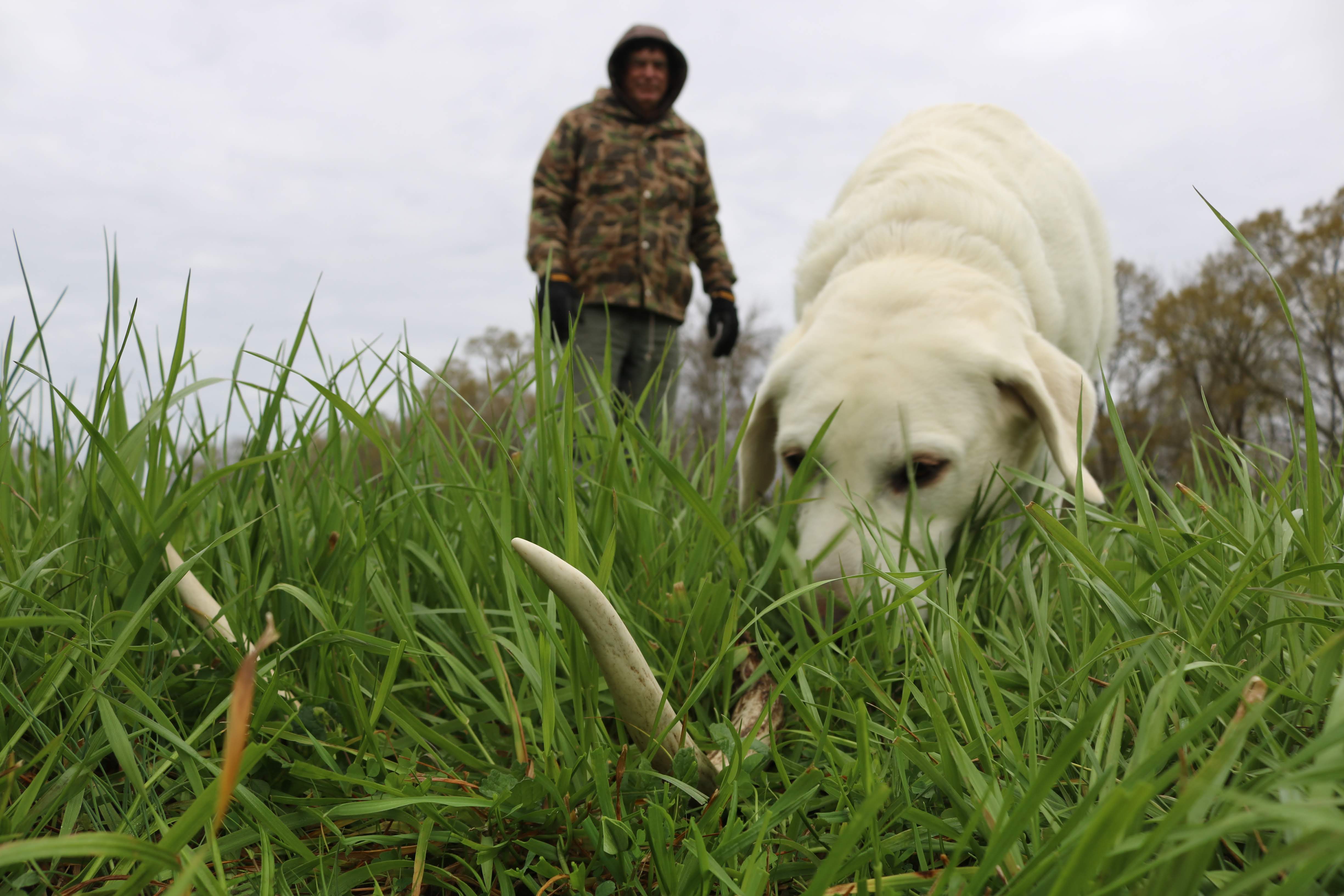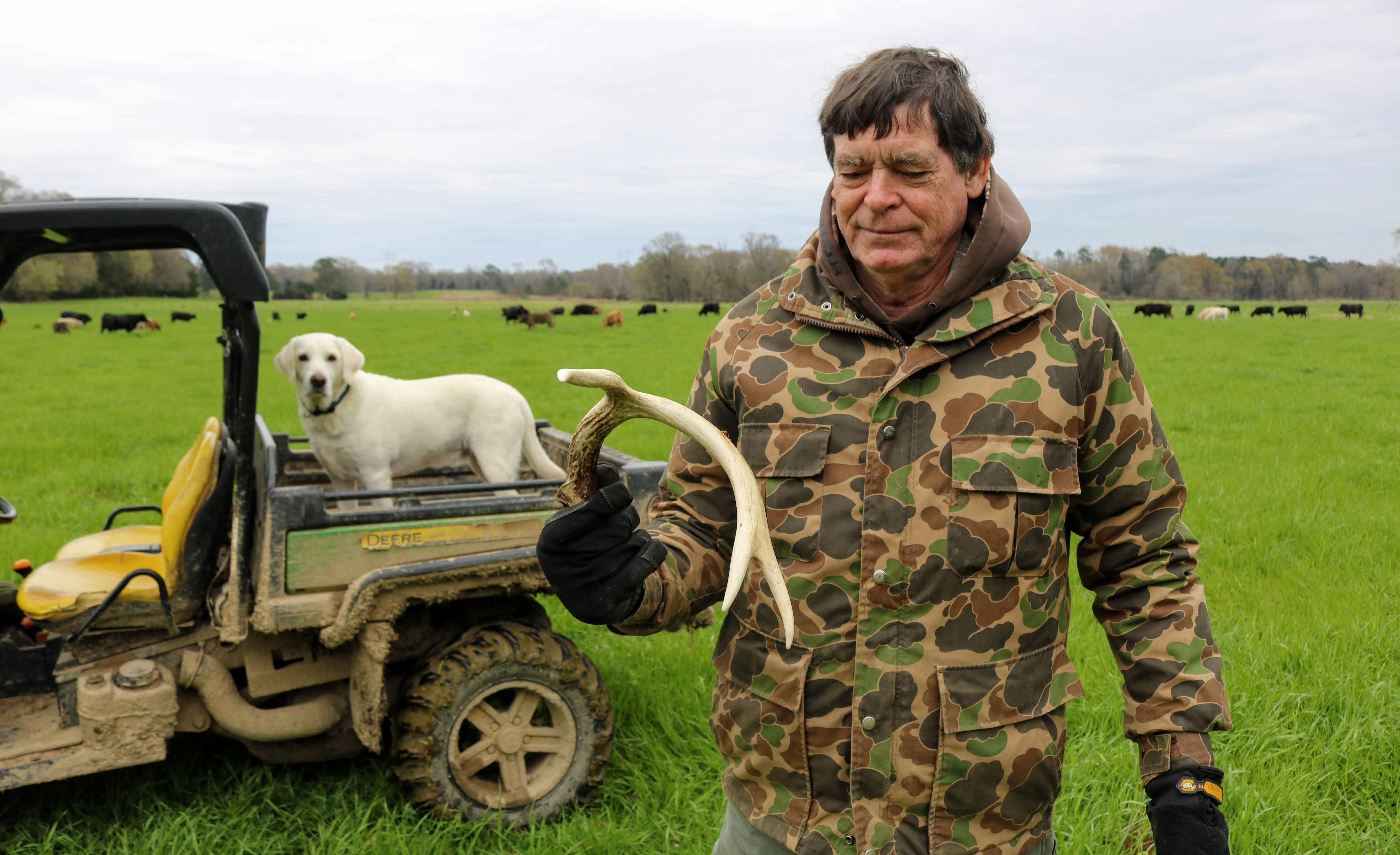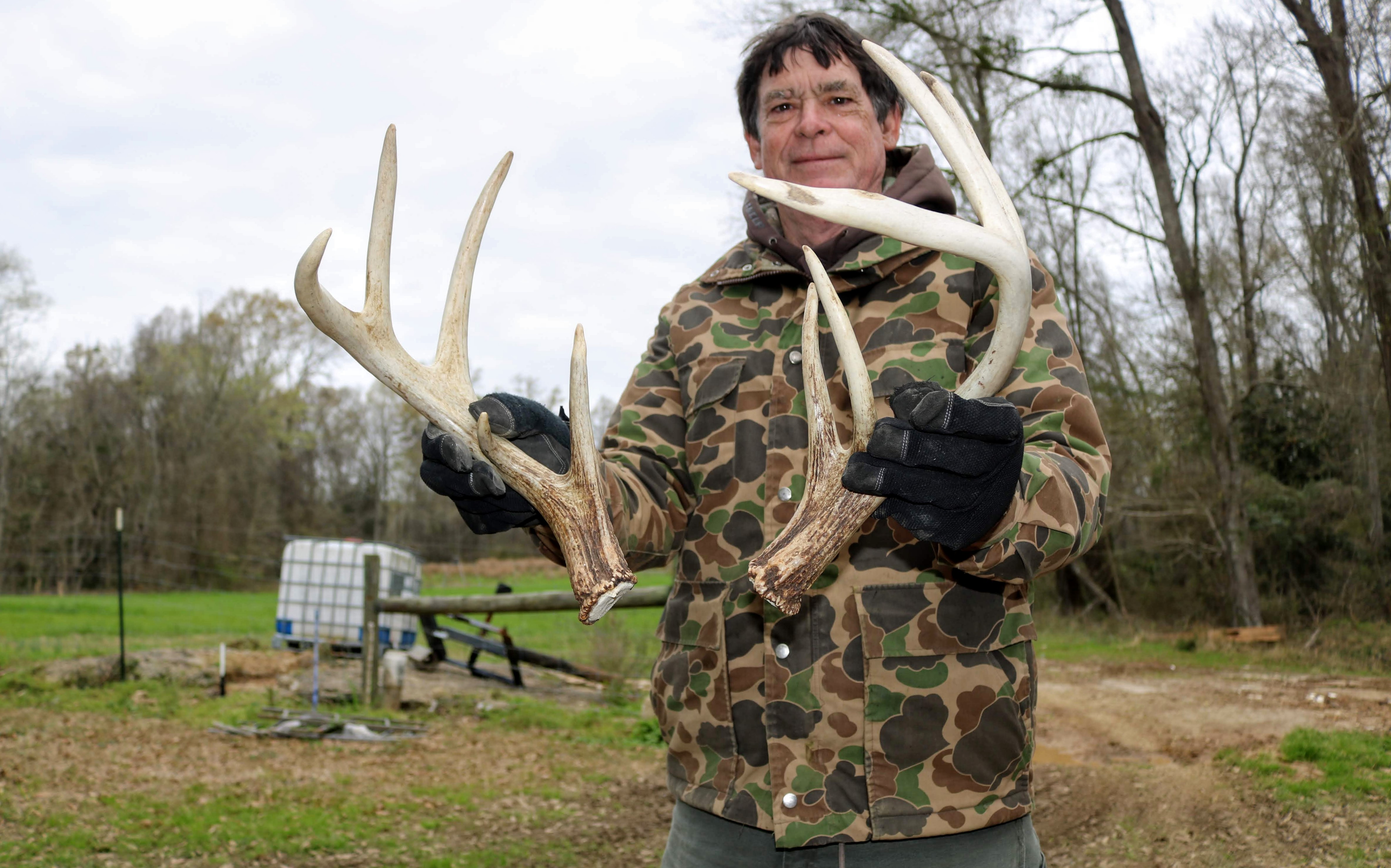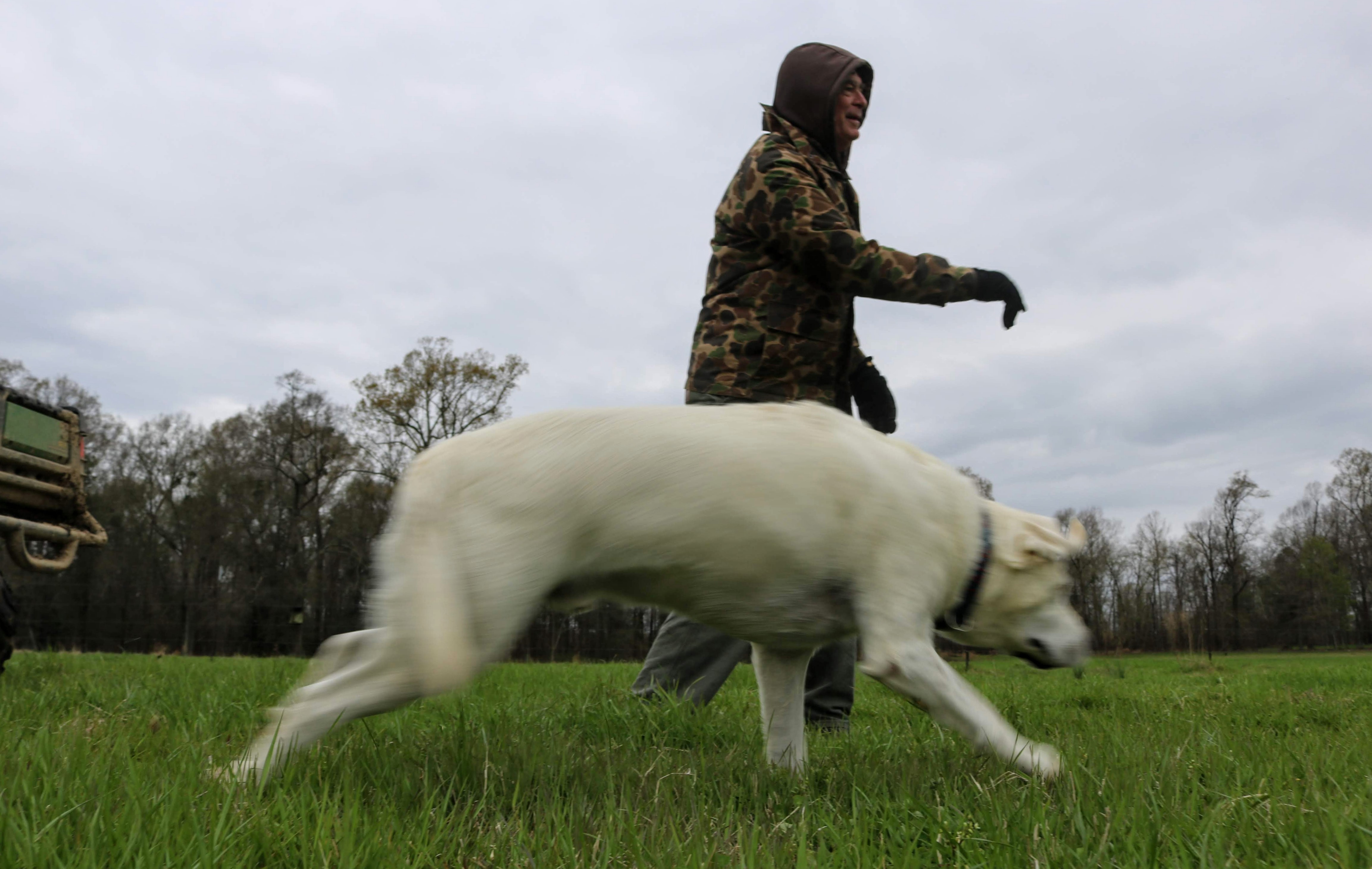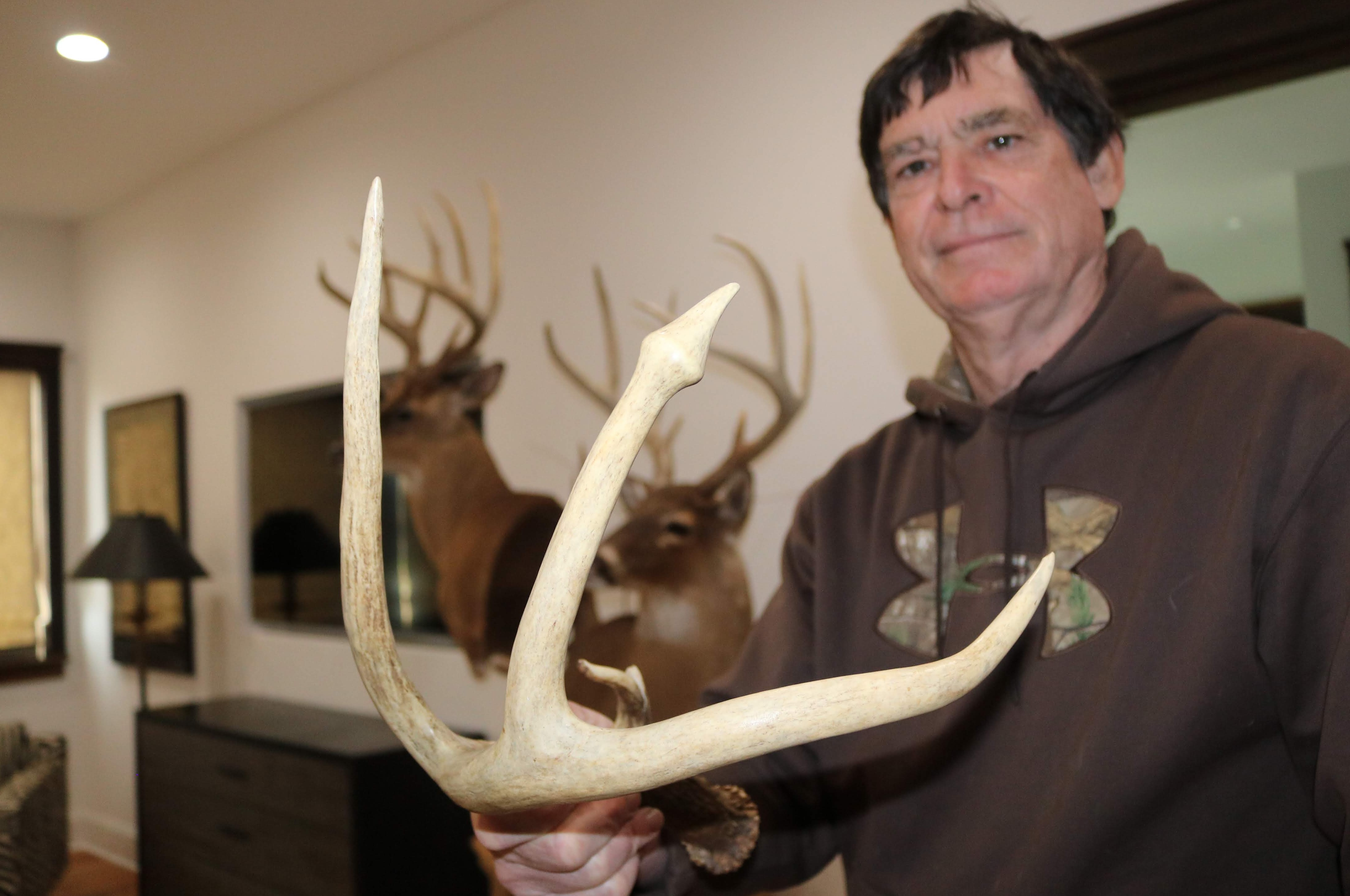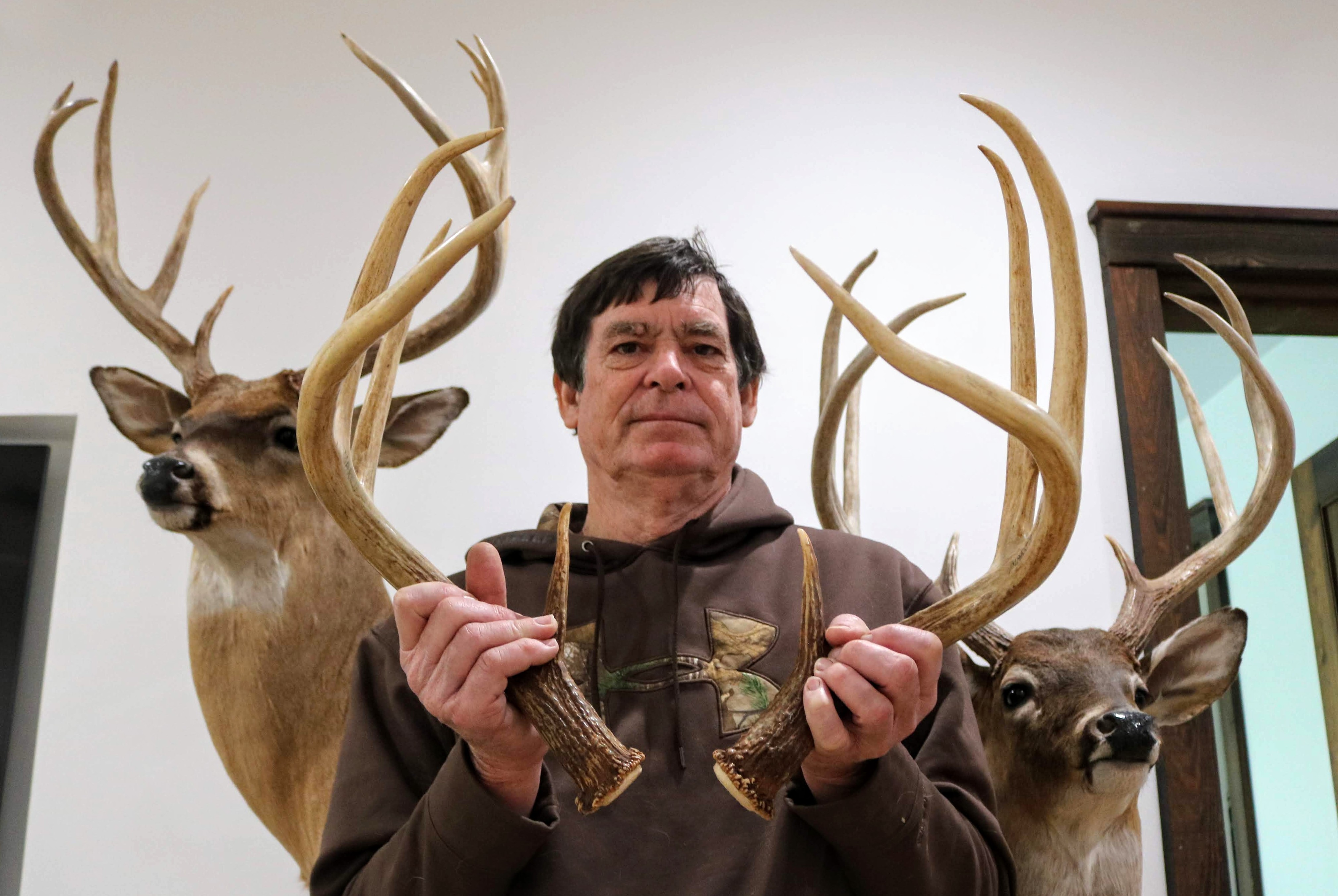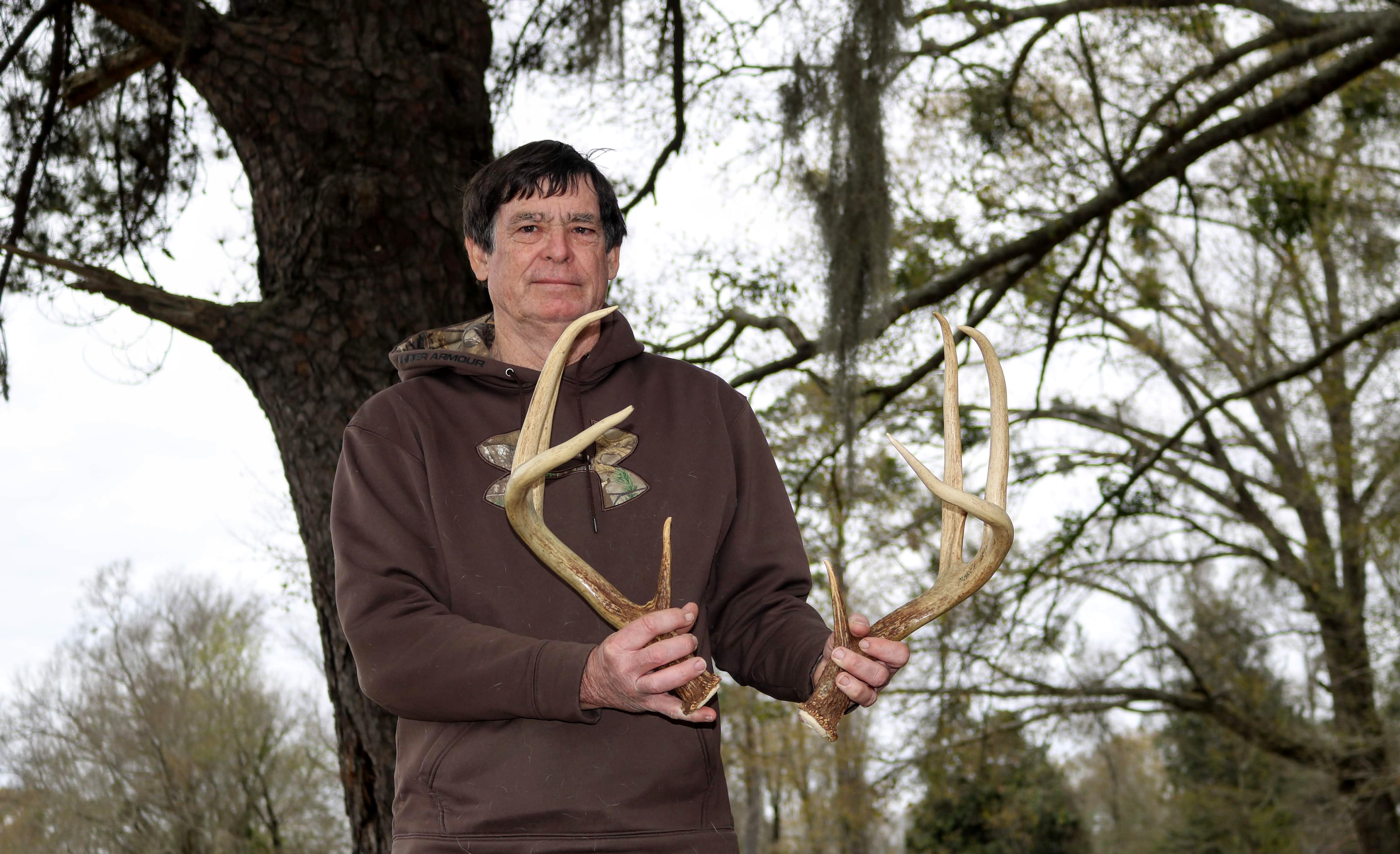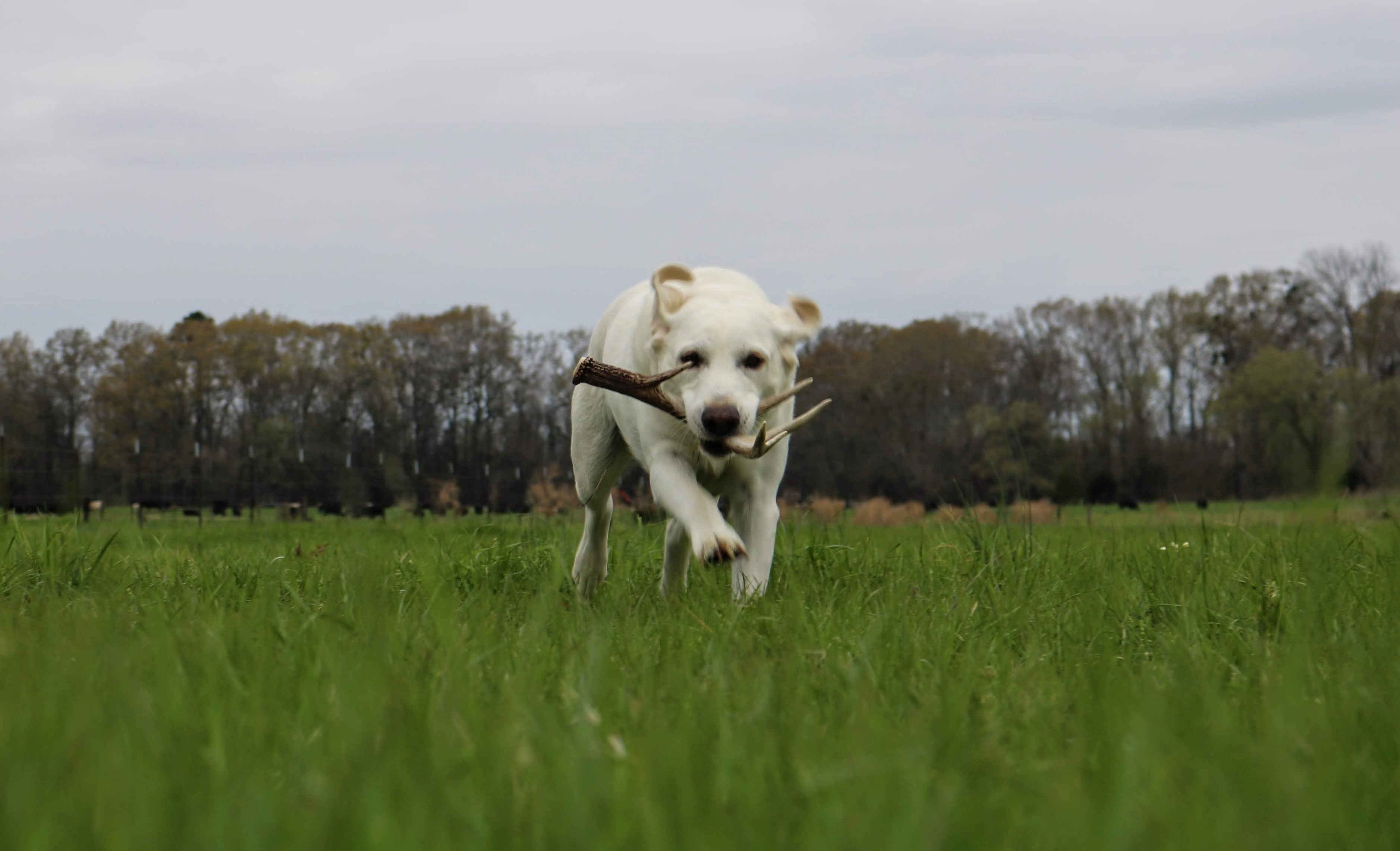In the Blood: Hunting Deer Antlers with a Legendary Shed Whisperer
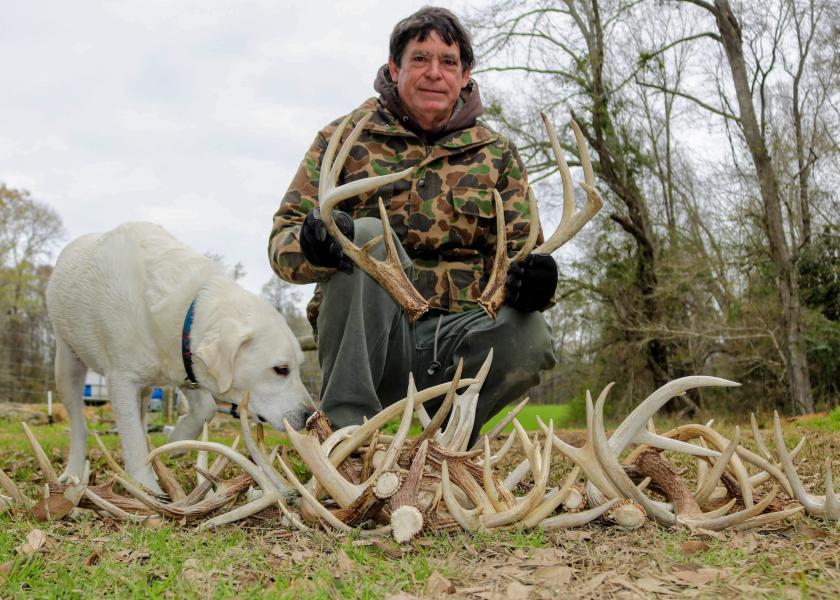
Where kudzu-covered bluffs meet bayous and cypress limbs drip Spanish moss, Jimmy Cassell is on the hunt for deer antlers. Perched behind the wheel of a John Deere side-by-side, Cassell patiently scans the horizon for an alabaster anomaly hiding in a sea of green. Eyes narrowing and neck tightening, he spots a pale speck 150 yards across an open field, and begins rolling toward a white gleam jutting just above a stand of early March ryegrass. Seconds later, heart pounding with anticipation, he picks up a stout 5-point trophy—one more shed to add to a stunning collection of deer antlers. At play in the fields of his youth, the search for sheds never gets old for Cassell, even after 30 years and over 1,500 specimens.
Shed hunting is a late winter and spring sport for millions of landowners and outdoorsmen in the United States, yet, few hunters can match Cassell’s consistent totals or antler size. Humble and self-effacing, he shakes off personal “bloodhound” credit and insists the key to prolific shed success rests on twin pillars of geography and deer management. Bouncing from the science of genetics to the purest juvenile joy, Cassell is the rarest of hunters—a genuine shed whisperer.
For the Love of Sheds
Just outside Port Gibson, roughly 45 miles northeast of Natchez, Miss., Cassell runs cattle on 1,000 acres of windblown, loess soil that rub against the Mississippi River in Claiborne County. In the mid-1970s, intent on following the farming footsteps of his father and grandfather, Cassell earned an animal science degree at Mississippi State University, but jumped tracks when the Port Gibson co-op called. Thirty-one years later, in 2005, Cassell retired as co-op manager, and went home to full-time farming. (Cassell’s family also grows corn and soybeans at a separate location.)
However, shed hunting began in 1989, when Cassell built a house on the farm and began removing sheds as a means to protect tractors and hay equipment. “In the very beginning, I started this to keep our tires intact. It was either get out there and pick’em up or deal with equipment damage.”
Essentially, Cassell’s land sits on high ground, atop a peninsula surrounded on three sides by bayous. He plants 120 acres of ryegrass in the pastures and extensive food plots (mixed with clover and turnips) beyond the livestock fencing. “Once the rye dies in May, the clover is there to carry the deer further, and we’ve also got a whole lot of acorn trees and plenty of kudzu. For deer to grow good horns, you have to be sure they can get all they want to eat. Otherwise, deer won’t grow the horns to their full genetic capability.”
“If a big shed is laying up right, you’re liable to see it from 200 yards and that’ll make your heart jump. You’re looking for a white pattern, but so much of the time you’ve got to be within feet before you can see it, even in a green pasture. In the woods, you’re dealing with the heavy camo of sticks and leaves, and that’s why I stick to trails and bedding areas.”
Cassell pays close attention to paths connecting woods and pastures. With 13 trail cameras providing a steady stream of visual data, he knows the rough location of particular bucks. “I’ll eventually check their bedding areas, but not too early because mature bucks don’t like to get bounced. It’s pretty simple; the horns are all gonna fall and it’s a matter of whether you can find them.”
An Ever-Climbing Tower
Depending on location, whitetail deer typically lose antlers from January to April, and grow a new set over the summer months. After the rut and a diminishment in testosterone levels, the antler drop window begins shortly afterward, all in a cyclical direction toward regeneration and a brand-new set of antlers. For Cassell, the drop window generally is heaviest between Feb. 1 to March 15. In early February, he begins riding fields, looking for the first signs of shed season. “I get excited to see the first one. Then I get sparked and start looking every day.”
He averages 50-60 sheds a season and sometimes locates a few bonus sheds in April while looking for lost cows in the woods, or finds a pasture-deposited shed in mid-summer, thanks to transport by a foraging coyote.
Cassell turns his cows in on ryegrass every morning and takes them off each afternoon. Translation: He checks at least some pastures for sheds twice a day. Cassell loads up Jack, his white Labrador retriever, into the bed of the side-by-side, moves the cows, and then starts the daily hunts in the fields or along the edge of the tree line. (Although a fixture on the hunt, Jack is not a trained shed-dog, but does drag an occasional shed from the woods.) After winter wear, deer hammer Cassell’s ryegrass to replenish weight, spend the night inside his pastures after eating, and consistently drop antlers.
A hunt with no finds is rare for Cassell. He usually returns to his shop with two to five sheds and deposits the haul into a 30-gallon black tub spilling over with antlers from the season. Once the drop window closes, some antlers are given away, or become knife handles, trinkets, lamps, and furniture, or are added to a massive shed tower in the corner of Cassell’s trophy room. The ever-climbing tower is an outstanding tangle of antlers—7’ high and 5’ wide at the base.
Cassell keeps an eye out for matched sets. “If it’s a big shed, I work hard to find the other. Generally, I look in a 200-yard radius because that’s likely where the match got dropped. Sometimes, even way after the rut, two bucks get together and bump horns, and that’s when you might find a matched pair laying very close.”
“People always tell me they can’t even find a single shed, but if you want good sheds, you’ve got to have mature bucks. If you shoot every 8-point you see with a rifle, then you’re not going to find any sheds. We’ve got a very unique situation going on here.”
Unique situation, indeed. Cassell estimates a deer population of 250-300, frequently spiking during high water. He culls 30 does per year, resulting in a doe-to-buck ratio close to 1:1. In addition, Cassell only kills (strictly bowhunting) bucks at 5½ years or older, sometimes a maximum of three to five per year. “We try not to kill anything young except management bucks. If a deer is only six points at 3½ or 4½, we’ll probably go ahead and shoot. Growth is the key and you have to recognize what’s going on and act accordingly. We also only bowhunt and that means deer are much harder to kill.”
In addition, Cassell is “blessed” with good neighbors. “If you’re in an area where your neighbor shoots everything, you’re not going to find many sheds. No bucks means no sheds. We’re so fortunate to have great neighbors that care about management.”
Mike Easley, a long-time friend and hunting partner, says although Cassell is “humble” in all areas of life, his knowledge of sheds is remarkable. Cassell’s ability is entirely unique, Easley describes: “He’s in the perfect spot, but I still can’t believe how many sheds he finds. Even when we’re squirrel hunting, he might come up with two or three sheds, and he saves each one. Frankly, I can’t figure out how he finds so many, especially the matched pairs.”
“At least in our area of the country, I’ve never heard of or met anyone who finds this many sheds,” Easley continues. “One corner of his game room is packed to the ceiling with sheds, and that’s just part of what he’s found.”
Acorn Tip
According to Cassell, the recipe for plentiful sheds equates to proper deer management, great soil, ryegrass, clover, kudzu, and bountiful oak trees (acorns). “Basically, you have to maximize the genetics,” he notes.
Mississippi consistently ranks highest in mature buck harvests, according to Quality Deer Management Association (QDMA) statistics. The QDMA Whitetail Report 2019 places Mississippi at No. 1 in the U.S., harvesting 77% of 2017-2018 bucks at 3½ or older.
“I never stop learning and I love to watch a deer mature from year to year. I pick up the sheds from the same bucks over and over, and I really learn a lot about which deer made it through the season.”
Case in point: Acorn Tip, a buck killed by a bowhunting neighbor at 7½. In prior years, as management trophies, Cassel found Acorn Tip’s sheds at 2½, 3½, 4½, 5½, and 6½. Acorn Tip was a straight 8-point all the way to 6½, and then jumped to 10 at 7½. He was 150” at 4½; 160” at 5½; 165” at 6½; and 170”-plus at 7½. “Acorn Tip grew a little knot in his third year and earned his name. A 170” deer is something else, especially when you’ve got all his growth right in front of you. Acorn Tip’s sheds might just be the most enjoyable ones I’ve ever found, and that really says something about letting a buck mature.”
When Cassell collects a clearly defined chain of antlers, he often gifts the sheds to whoever kills the associated buck. With Acorn Tip, Cassell provided his neighbor with the 6½ set. “Just look at Acorn Tip that Jimmy followed for so many years in a row,” Easley describes. “He gave those antlers to the hunter and that’s the kind of guy Jimmy is. He’ll do anything for you; he’ll help people in a second.”
Wild Pig Troubles
The advantages of Cassell’s farm location also carry a serious detriment to a healthy deer population, related to competition for food and destruction of pastureland—wild pigs. Over the past several years, Cassell has been forced to trap and night-hunt with an AR-15 (thermal), killing approximately 150 wild pigs per year. The number of kills appears high, but in reality, the tally merely keeps the wild pig population in check.
However, recent changes to Mississippi hunting regulations allow for deer baiting, a switch that’s produced significant benefits for Cassell: “We deal with Russian-type hogs, not the spotted crossbreeds, and the Russians are much, much harder to trap. Right now, we’ve finally got the hog numbers in check, and that’s because so many people around us kill hogs on feeders set up for deer. We don’t shoot deer over bait, but many neighbors do and that has really cut down on hog numbers. Baiting laws have definitely helped with hog control, at least on our farm.”
The Shine of a Shed
Over the years, Cassell’s pursuit of sheds has gained an edge over his zeal for deer hunting, and he now leaves the buck harvest for younger relatives. What started as a necessary chore to protect equipment has developed into a consuming passion for nature. “I guess I’d rather find sheds than kill a deer. It’s pure enjoyment to see how a deer progressed in life. A lot of the time when someone kills a deer out here, I recognize that I found that same deer’s sheds right in the same vicinity where the kill was made. Sure, a buck moves all over the place during rut, but otherwise they shed in the same locations.”
Every shed carries its own chronicle, Cassell emphasizes. “Some years back, a 14-point dropped his horns right at my ladder stand, just to laugh at me and remind me I wasn’t able to kill him. We never got that deer and he died of old age. He was just too smart and too nocturnal for us. I never forget stories like that.”
Despite his prowess, Cassell contends he has no shed-finding ability beyond the norm. Plainly stated, the secret to sheds boils down to buck presence, he insists: “I guess I’ve never met anyone around here that’s found more sheds, but I know guys out West find a whole lot. I’m no better than anyone at this and I have no sixth sense. I just know that so many clubs and hunters kill all their bucks and then can’t figure out where the sheds are.”
Cassell was “meant” to hunt sheds, according to Easley: “Jimmy knows that ground like the back of his hand and he knows where those deer are at. This is in Jimmy’s blood, and as long as he is able in life, you’re gonna see him out there finding sheds like nobody else. He’ll be doing this forever.”
It takes a large beast of a buck to get Cassell’s attention, but the tiny distant shine of a hidden shed is enough to excite him to the core. “When I see the sun reflecting off a nice shed in the distance, my heart goes to thumping, and I guess that proves how much I truly love this.”
“In a way, it brings out a natural joy and makes me feel like a kid,” Cassell adds. “I’ll always have to pick’em up to protect my tires, but the truth is I just love sheds and watching deer grow. There’s something special because every shed tells its own story.”
For more, see:
Killing Hogzilla: Hunting a Monster Wild Pig
The Living and the Dead: Black Vultures Expand, Farmers Pay Cost
Agriculture's Darkest Fraud Hidden Under Dirt and Lies
Blood And Dirt: A Farmer's 30-Year Fight With The Feds
Living the Dream: Honoring A Fallen Farmer
Pigs Don’t Fly: Feral Hog Spread Is A Man-Made Mess
Who Killed the Finest Soybean Soil in the World?
Hemp Fraud Hits Farmer With Clone Scam
Seeds of Discord: Crossing the Great Cover Crop Divide
Bald Eagles a Farmer's Nightmare


